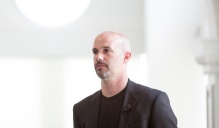Our team
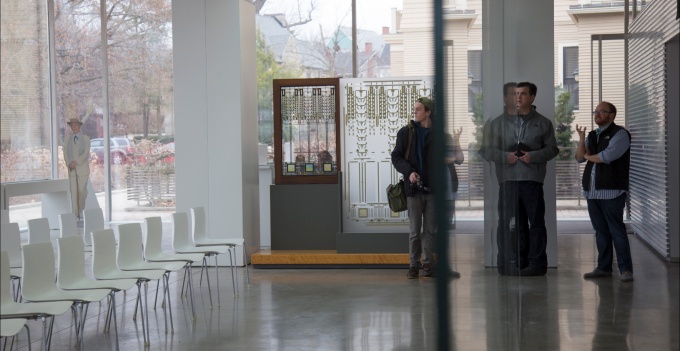
Filmmaker John Paget (right) and UB's Biennale team scouting sites for the film. Photo by Maryanne Schultz
Creative directors
Creative direction for the project was provided by UB architecture faculty members Gregory Delaney, who served as director of the film and curator of the overall exhibit; and Korydon Smith, assistant director and assistant curator. For the production of the documentary, the school worked with local filmmaker John Paget.
Gregory Delaney
Curator, Director
UB clinical assistant professor of architecture
Gregory Delaney is a graduate of The Ohio State University’s Knowlton School, where he earned his degrees (B.S. in Architecture and M.A.S. in Criticism) and taught courses in architecture and landscape architecture before moving to Buffalo in 2011. His work focuses primarily on the research, documentation, and cataloging of significant built works of architecture and landscape architecture in the United States. As a designer and historian, Gregory teaches both design studios and core courses in the areas of history and theory in addition to running intensive travel programs for students in architecture and planning.
Korydon Smith, EdD
Assistant curator, Assistant director
UB professor of architecture
Serving as Professor and Associate Dean in the School of Architecture and Planning and Co-Director of the Community of Excellence in Global Health Equity, Korydon Smith conducts research on planning and design for diversity, health, and social justice in the United States and abroad. He has traveled widely throughout Europe and North America, and has done collaborative, applied research in Rwanda, Uganda, India, and Costa Rica. He is currently working on his seventh book; past works have included – Inclusive Design: Implementation and Evaluation (2018), Diversity and Design: Understanding Hidden Consequences (2015), and Introducing Architectural Theory: Debating a Discipline (2012) – all with Routledge press. Smith holds an Ed.D. in higher education leadership as well as a professional M.Arch. degree, and has received seven awards for outstanding teaching.

John Paget, First+Main Films
Producer, Director of photography
With 25 years of experience, Paget has shot, produced, directed and edited several award-winning and nationally broadcast documentaries. His exceptional storytelling instincts and craftsman-like approach to cinematography are supported by advanced technical skills and a distinct ability to capture the city of Buffalo. His filmography also includes documentaries on iconic American topics like Route 66, Elvis Impersonators and Alcatraz Prison. He's traveled worldwide to produce commissioned projects for international non-profits, TV networks, and Fortune 500 companies. Originally from Olympia, Washington, John now lives in Buffalo, New York. He's made several celebrated short films about Buffalo, including Buffalo: America's Best Designed City, This Place Matters and Buffalo For Real.
Executive leadership

Robert Skerker
Executive Producer
Bob Skerker is a long-time leader and steward of Buffalo's cultural and architectural assets. His interests focus on the intersection of community resources and assets that can be leveraged for economic development and regional growth. Currently he serves as a director of the Darwin Martin House (Martin House Restoration Corp.), President of Kleinhans Music Hall Inc., (Buffalo), Director of the BPO Foundation (Buffalo), Director of the Frank Lloyd Wright Foundation, and as a Governor of Taliesen School of Architecture of Scottsdale, Arizona, and Spring Green, Wisconsin. He serves on the board of two private companies in the Buffalo area. Mr. Skerker was Chairman and Chief Executive officer of Robinson Home Products (Buffalo) from 1986-2006, and, after selling his company to its employees, helped start The Jacobs Institute (Buffalo Niagara Medical Campus), serving as its president in 2014. He served as co-chair of the National Preservation Conference held in Buffalo in 2011. He is also Director for North America of IZE LLC, a UK based manufacturer of architectural hardware.

Robert G. Shilbey, FAIA, FAICP
Associate Producer
Dean and Professor, School of Architecture and Planning
Bob Shibley has dedicated his career to advancing knowledge-based design and placemaking in service to the public. Dean of the School of Architecture and Planning since 2011, he joined UB in 1982 and holds professorships in architecture and urban planning. As founding director of UB's Urban Design Project, he oversaw the City of Buffalo's development of internationally award-winning plans for its downtown, waterfront and Olmsted park system, and a city-wide comprehensive plan. He continues to advance this work through the UB Regional Institute, which aligned with the Urban Design Project in 2011 to provide research and planning support for a new wave of regional planning efforts. Prior to his appointment as dean, Shibley led the development of UB 2020: The Comprehensive Physical Plan as a senior advisor to UB’s president. As campus architect, he led international design competitions for UB’s new downtown medical school and the Solar Strand, a ground-mounted solar array and land-art installation on UB’s North Campus. Shibley is the recipient of 14 life-time achievement awards including the American Institute of Architects Thomas Jefferson Award for Public Architecture and the James R. Haecker award for leadership in architectural research from the Architectural Research Centers Consortium.
"This film and exhibition is an effort to ground this future of architectural education and its global reach in the communities that host the educational enterprise.We learn from our city and region every day and they learn from us. Together we reach for the global impacts that rebuild our cultures, sustain our planet, and substantiate the relevance of architecture and planning in the twenty-first century."
- Dean Robert G. Shibley, excerpted from the exhibition catalog
Full film credits
Director: Gregory Delaney
Producer: John Paget
Executive Producer: Robert Skerker
Director of Photography: John Paget
Editor: Thomas Warner
Associate Producer: Robert Shibley
Music Composer: Eli Bennett
Sound Designer: Daryl Bennett
Assistant Director: Korydon Smith
Timelapse Cinematographers: John Paget, Thomas Warner
Aerial Cinematographer: Brandon Moran
Contributing Videographers: Nathan Peracciny, Kyle Toth
Equipment Technicians: Gerard Kawczinski, Wade Georgi
Full exhibition credits
Curator: Gregory Delaney
Assistant Curator: Korydon Smith
Projection and Sound Engineer: Eric Burlingame
Graphic Designers: Frank Kraemer, Morgan Mansfield
Fabrication Technicians: Kalyn Faller, Nicholas Wheeler
Student ambassadors

Students have been involved in the production, curation and installation of the exhibit. A team of five students have played a central role in development of the exhibit, the design and fit-out of the exhibition room at the Palazzo Bembo, the assembly of exhibit components, and the design and production of a supporting catalog.
Additional students will head to Venice this summer and fall for workshops and a study abroad program being organized around the exhibit.
Learn more about our student support team:

Eric Burlingame is tasked with the design of the audio-visual technology for the School’s exhibition space at the Palazzo Bembo in Venice, which makes sense since he worked for a decade as an audio technician at UB’s Center for the Arts before deciding to pursue a Master of Science in Architecture degree in Universal Design.
Specifying the equipment for the installation in UB’s assigned room – thirteen by nineteen feet with eight-foot high ceilings – was a fairly straightforward assignment for a technician with experience like Eric. Picking out some high-quality home-theater grade speakers for the small space – instead of the industrial strength equipment he was used to at CFA – was a little twist.
The main challenge was to figure out how to get up the room – which adjoins two other exhibits spaces on either side – so that sound from Buffalo’s movie wouldn’t bleed out or sound from other exhibits bleed in and still be loud enough for those in the exhibit to enjoy.
The task was not far afield from his thesis research on classroom acoustics (He will graduate it May shortly before flying off to Italy). And he has learned a lot from his advisory committee – Edward Steinfeld, Sue Wiedemann, and notably, Paul Battaglia, who has been teaching acoustics at UB for four decades.
Eric will be in Venice for about a week, installing his elements of the exhibit, while assisting the other A/P team members to create this special work. He will be there for the opening on May 24 and then fly home. In the time in between he’s eager to see the great architecture and culture of that city on the water.
“I’d really just like to go explore.”
In the future, Eric imagines going into business as an acoustical consultant to architects and designers. And maybe there will be time for his other vocation. Burlingame, who earned his B.A. in music at the University of Buffalo, is a professional theatrical sound designer, composer, live audio engineer, and musician.
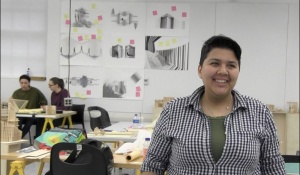
Kalyn Faller wanted to study architecture. She wanted to go to a state school. She wanted to get out of Queens. So, UB seemed like a good possibility. The tour led by Greg Delaney sold her on Buffalo. The energy of the place, the excitement of the students, the range of projects and events, and especially the shop, closed the deal.
“All the activity in the shop made me feel like I would be building.”
Which was perfect for someone seeking a hands-on experience. Now Kalyn works in the “Fab Lab” helping other students with their projects – to find materials, choose the right machines, learn how to use them. Her personal favorite among the digital tools is the CNC (Computer Numeric Control) machine. “The capabilities are endless.” Among the analog tools she is partial to welding. “I never thought as a student I would learn to weld.”
“Every day is different depending on what project the student walks in with,” Kalyn said. “But we are basically problem solvers.”
That made her a natural for the Venice team. Kalyn is paired with Nick Wheeler to fit out the exhibit space in the Palazzo Bembo. Their main task left before the opening in late May is to design and produce a bench for visitors to sit on comfortably while they watch the seven-minute movie about the Buffalo School.
Kalyn, Nick, and Greg Delaney are considering a slatted wooden bench that would be assembled out of computer-cut C-shaped elements secured by slender lateral rods – easier to put together on-site than something from Ikea and easy to ship. Their choices are complicated by the need to locate a one-foot-cube sub-woofer audio speaker underneath the bench.
Her first year in the program she confined herself to just classes and studios. It didn’t make her happy. Second year she started getting more involved.
“The next thing you know I’ve got my hands in everything.”
She helped Julia Jamrozik and Coryn Kempster fabricate and finish their simple and flexible Modular Display System for the Hayes Hall atrium. She assisted Banham Fellow Ang Li install her beautiful terra cotta sculpture “No Frills” sculpture for the Echo Art Fair. Kalyn is also president of Alpha Rho Chi, the architecture student fraternity, which makes her point person on planning and prep for everything from opening week to Atelier and Beaux Arts Ball to awards day.
Kalyn is the veteran traveler on the five-member Biennale team. She took the study abroad opportunity in Madrid last year, working with faculty leader Miguel Guitart to plan weekend excursions with her colleagues. In August, she and three friends rented a car to see France, Germany, Switzerland, and Italy.
So, Kalyn has been to Venice. She and her companions were determined not to use a map, which meant they spent the first day and a half lost, running into dead ends or to the water’s edge. Eventually they understood that Venice is composed of two interlocking “hands” with bridges to cross in only four places. But maybe she should let her colleagues find their own way.

The concept for UB’s exhibit at the Venice Biennale is simple, second-year M. Arch. student Frank Kraemer explains. It’s not a busy room full of images or objects, but a darkened space in which to see a short film that evokes the long relationship between a school and the city that it serves.
And a simple memento in the form of modest booklet.
“It’s just you, this film, and this pamphlet you’re going to walk away with,” Frank said.
He and junior architecture student Morgan Mansfield are tasked with producing the piece which will combine still images from the video now in production by Buffalo filmmaker John Paget with extended captions to briefly explain each view.
Like a lot of freshmen, Frank came to UB with his intention to study architecture only partly formed. As a kid growing up in Long Island – “I listened to music, skateboarded, and drew” – he was a doodler and a drawer, good in math in physics. Advisors told him to consider engineering or architecture.
He applied to UB, got accepted, came for a visit. “I had a great tour, loved the shop. I saw all the finished products, so that was cool,” even if he didn’t initially appreciate all the hard work and long hours that went into design studio projects.
Into his sophomore year he still wasn’t really sure why he was getting into architecture and he knew he wasn’t doing that well. He moved into the Environmental Design track and graduated with the BAED in 2016.
It was a useful interlude. It broadened the way he thought about design but it didn’t satisfy his hunger for something more tangible to be the object of his work – like a building. Architecture felt like his “unfinished business.” So, he came back for the 3½ year M. Arch. program
He’s doing well. Last fall he and fellow student Jelani Lowe won honorable mention in the Future House Organization micro-house design competition for their “BLOOM” house, a 483-square-foot dwelling that strives to integrate technology and environment for comfort and efficiency.
Frank also works for Shannon Phillips, Assistant Dean for Graduate Education, helping with recruitment and admissions. He fields a lot of questions via e-mail and telephone, many from international students, about the application process, financial aid, the student experience, when they can take a tour.
He also assisted Phillips with a review of the syllabi in the Department of Urban and Regional Planning aimed at guiding the infusion of gender and race in the curriculum, both themes and authors. And he’s on the editorial committee for the school journal, Intersight.
Unlike three of their colleagues, Kraemer and Mansfield won’t go to Venice for the installation in May. Rather they’ll wait until August to participate in workshops as part of a study abroad program being organized around the exhibit and Biennale. Meanwhile, he’s scheduled to participate in the Madrid summer study program.
“I’m probably going to stay in Europe for the summer and make my way over to Italy,” when the time comes. “It’ll be nice to see it in its full form,” Frank said. It will be great to see something he’s worked on displayed on a global stage.
“That’s awesome. Anything after that, I’m grateful for.”
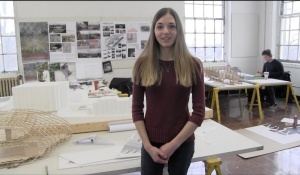
Even a simple pamphlet, like the one planned as a memento from UB’s May-to-November exhibit in Venice, is a design problem that needs a solution.
What size paper? Which still frames best represent the short film? What captions? What font? How many pages? What binding? How should they be displayed in the exhibit space at the Palazzo Bembo in the city of canals?
All of that is being worked out by Morgan Mansfield and her student colleague, Frank Kraemer. It’s not a huge task, but a designer still has to carry a vision forward, still has to consider every detail in making the vision a reality. And somehow you never end up quite where you initially thought you were headed.
It’s the kind of problem Morgan, a junior architecture student, has grown to love.
Morgan grew up in Springville, New York with a powerful interest in art from a young age, always painting and drawing on her own. She began to take it more seriously in middle school, and attended the New York State Summer School of the Arts program at SUNY Fredonia in her mid-teens. Four solid weeks of nothing but artwork. It was great.
When it was time for college she thought about architecture. She applied to multiple schools across the state, and eventually settled on staying in Buffalo.
“UB just felt friendlier, in a way,” Morgan recalled. “More welcoming.”
Now a junior in the undergraduate architecture program, she’s become acquainted with some of the other rewards of study in architecture at Buffalo.
“Everyone told me it would be a lot of work. Everyone told me it would be a lot of fun. But I didn’t know how interdisciplinary it would be. Somehow art and technology and people are all involved and you have to work out a solution that meets all the parameters,” she said, “and that’s what I like most about it.”
Morgan has also enjoyed an introduction to the professional scene, working in the private firm of professors Georg Rafailidis and Stephanie Davidson. She’s done representational work mostly, including sketch designs, design development, 3-D work in Rhino, and graphic animations. Clients include local developers with historic properties to retrofit. Morgan enjoys being in a small firm, where she can help throughout the entirety of the design process.
Morgan and Frank have a little more than a month to produce their pamphlet and finalize the exhibition design. They like what they’ve seen so far of the film now in production. It’s not a “shiny, touristy” depiction of Buffalo, she said, but a more honest one. And their pamphlet will be there “so people can come and take part of the exhibition with them.”
It won’t be her first trip abroad. She visited Europe in high school, but that was four countries and nine cities in eleven days – France, Spain, Italy, Monaco. Venice in August will be at a more relaxed pace. There will be time to sight-see after the study-abroad workshop and the exhibit itself.
“The Biennale is going to be really inspiring to see.”
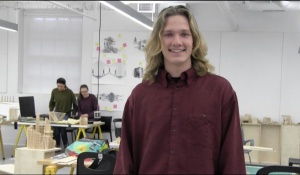
Nick Wheeler grew up in the Village of Attica, NY, population 2,470, and went off to study engineering at Genesee Community College, fifteen miles away in Batavia.
“I thought it was going to be hands-on design,” he recalled. “But it was all math.”
Not that there is anything wrong with math, but he wanted a more tangible encounter with design and transferred to UB for architecture. Now, along with Kalyn Faller, Nick is charge of designing the exhibit space in the Palazzo Bembo, sourcing materials, building components and figuring out how it gets from here to there.
The design of the room is simple. It involves curtains against the side and front walls plus two shorter curtains across two doors at the back of the room. The curtains are to darken the room, reduce reflection, and dampen the sound, as well as to cover outlets or conduits on the wall, the media box, and the audio receiver.
Cost is definitely an object. For example, they’ve settled on a track and curtain system sold by a company in New Jersey that they can pack and take on the plane for $100 excess baggage fee instead of paying $3,000 to have it shipped.
Next they’ll design a bench and the challenge is similar. Do they design something that can be built quickly once they get to Italy or do they design and fabricate something here that can be shipped cheaply and disassembled and reassembled on the way?
Nick worked the past two years in the school shop. He also worked with UB faculty member Dennis Maher at SACRA – the Society to Advance Construction Related Arts – an education and job-training program conducted at Maher’s deconsecrated church building in Allentown. The Erie County Department of Social Services recruits trainees to learn high-demand construction skills from local tradespeople, craftspeople, artists, and students like Nick.
Nick is on target to earn his Bachelor of Science in Architecture degree after the fall semester. He plans to continue straight on to grad school. He’ll stay in Buffalo. It’s affordable. He’s fallen in love with the city, and he has strong relationships with members of the faculty.
After the MArch he’ll prepare for licensure; with all this education why be anything but a full-fledged architect? He dreams of buying in an old house on the East Side and living there while he renovates. Then a sole proprietor practice, maybe work in the design-build realm.
Nick hasn’t traveled much and his expectations are… general. He’ll go to Venice and do his job, take whatever time he has to see the city, “soak it in,” and “eat some great food.” After that he’s headed for ten weeks in the sustainable futures program in Monteverde.
“I’ve never been out of the country,” he said, “and suddenly I’m going straight from Venice to Costa Rica.”
Nicholas Wheeler will put his making skills to work as part of the exhibit's fabrication team. He'll also make his first trip outside the states when he heads to Venice in May. "It's a great chance for me to see the world and experience a culture outside the U.S. And it's a great chance to represent our school and show off the work we do here."

